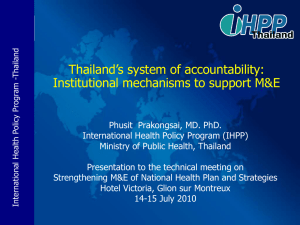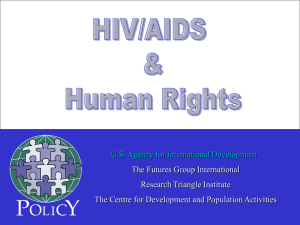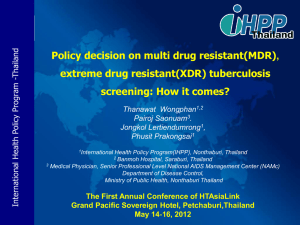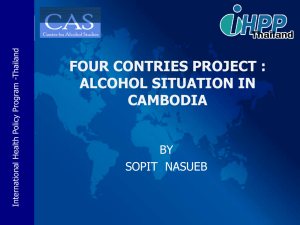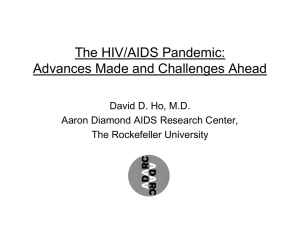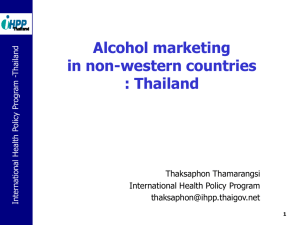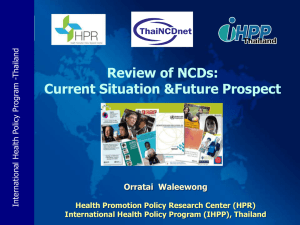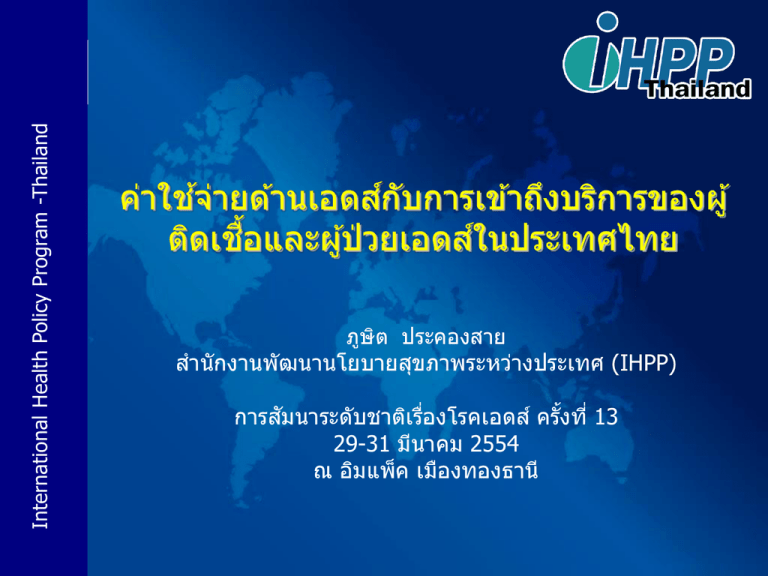
-Thailand
Program
Health Policy
International
-Thailand
Program
Policy
Health
International
์ บ
ค่าใชจ่้ ายด ้านเอดสก
ั การเข ้าถึงบริการของผู ้
ื้ และผู ้ป่ วยเอดสใ์ นประเทศไทย
ติดเชอ
ภูษิต ประคองสาย
สานักงานพัฒนานโยบายสุขภาพระหว่างประเทศ (IHPP)
ั นาระดับชาติเรือ
การสม
่ งโรคเอดส ์ ครัง้ ที่ 13
29-31 มีนาคม 2554
ณ อิมแพ็ค เมืองทองธานี
DALYs ranks in 1999 and 2004
Source: Thailand Burden of Disease Study 2004
Program
Health Policy
International
-Thailand
Program
Policy
Health
International
-Thailand
ี สูงสุดในประเทศ
ภาระโรค 3 อันดับแรกทีม
่ ค
ี วามสูญเสย
ไทยปี พ.ศ. 2547-2548
Top
1
2
3
(1)
DALY loss
(2)
Curative expenditure
HIV/AIDS
Traffic injuries
CVD
Traffic injuries
DM
HIV/AIDS
(3)
Economic loss
due to premature death
HIV/AIDS
Traffic injuries
Liver cancer/ CVD
(4)
Economic loss
due to absenteeism
Traffic injuries
DM
HIV/AIDS
หมายเหตุ เป็ นข ้อมูล 2548 ยกเว ้น DALY loss เป็ นข ้อมูลปี 2547
•
ี หายทัง้ 4 มิต ิ
อุบต
ั เิ หตุจราจร และ HIV/AIDS ก่อให ้เกิดความเสย
•
ี ใน 2 มิต ิ
เบาหวาน โรคหัวใจหลอดเลือด เกิดความสูญเสย
•
ดังนั น
้ การปรับทิศทางการลงทุนด ้านสุขภาพในประเทศไทย ควรจะให ้
ความสาคัญของการลดภาระโรค ในตารางด ้านบน
3
Health care finance and service provision of Thailand
Health
arrangements
andcoverage
three public(UC)
health
afterfinancing
achieving
universal
insurance schemes in Thailand after achieving UHC in 2002
Program
Health Policy
International
-Thailand
Program
Policy
Health
International
-Thailand
General tax
Ministry of Finance - CSMBS
(6 million beneficiaries)
General tax
National Health Insurance Office
The UC scheme (47 millions of pop.)
Tripartite contributions
Payroll taxes
Social Security Office - SSS
(9 millions of formal employees)
Risk related
contributions
Population
Patients Co-payment
Services
Traditional FFS for OP
Source: Tangcharoensathien et al. (2010)
Standard Benefit
package
Voluntary private insurance
Public & Private
Contractor networks
Full capitation
Capitation
Capitation
& OP
global
Capitation
for
budget with DRG for IP
DRG with global budget
FFSuntil 2006, DRG for IP
Direct
billing
FFS(2006+) for OP
Fee
for services
Fee for services - OP
4
400,000
25%
Achieving UC
350,000
32%
300,000
Million Baht
36%
250,000
200,000
150,000
100,000
50,000
27%
55%
53%
53% 46% 45%
37% 37%
36%
45% 44% 44%
75%
73%
64%
63% 63% 64%
54%
55% 55% 56% 56%
47%
45% 47%
68%
0
19
94
19
95
19
96
19
97
19
98
19
99
20
00
20
01
20
02
20
03
20
04
20
05
20
06
20
07
20
08
Program
Health Policy
International
-Thailand
Program
Policy
Health
International
-Thailand
Share of public and private sources of health
care finance in Thailand, 1994-2008
Year
Public financing sources
Private financing sources
Total health expenditure during 2003-2008 ranged from 3.49 to
4.0% of GDP, THE per capita in 2008 = 171 USD
5
Progressive health financing sources lead to equitable financial
contribution:
Kakwani indexes Kakwani indexes, 2000-2006
Out of pocket payments
Direct tax
Indirect tax
Premium Insurance
SHI contribution
Premium insurance & SHI contribution
Overall Kakwani index
2000
-0.150
0.391
-0.096
-0.362
0.165
Na
-0.0035
2002
-0.076
0.416
-0.069
-0.391
0.112
Na
0.0374
2004
-0.076
0.442
-0.043
-0.323
0.105
Na
0.0630
2006
-0.045
0.362
-0.083
Na
Na
-0.049
0.0406
2004
26.4
20.8
37.1
8.9
6.8
na
100.0
2006
23.2
24.5
35.2
9.2
7.9
17.1%
100.0
Share of health care finance (%)
Out of pocket payments
Direct tax
Indirect tax
Premium Insurance
SHI contribution
Premium insurance & SHI contribution
Overall Kakwani index
2000
33.7
18.0
33.4
9.6
5.3
na
100.0
2002
27.9
18.8
38.2
9.2
5.9
na
100.0
Financial risk protection (1)
Household OOP as % household income, 1992-2008
Health payment : Income (%)
8.17
8
1992
7
1994
6
1996
4.82
1998
5
3.74 3.65
4
2000
4.58
2.87
3
3.67
3.29
2
2002
1.99
1.64
2.78
2.38
1.69 1.66 1.74
2.05 1.95
1
2.57 2.45
2.22 2.06
1.68 1.66 1.83
1.68
1.74
1.55
1.27
2008
ec 9
il e
10
2004
D
ec
il e
8
D
ec
il e
7
D
ec
il e
6
D
ec
il e
5
D
ec
il e
4
D
ec
il e
3
D
ec
il e
2
D
ec
il e
D
D
ec
il e
1
0
1.27
2.18
Source: Analysis from household socio-economic surveys (SES) in various years 1992-2008, NSO
2006
Financial risk protection (2)
Incidence of catastrophic health expenditure 2000-2006
Incidence of catastrophic health expenditure 2000 to 2006,
Thailand, exceed 10% of total household income
6%
5%
4%
5.4%
4.0%
3.3%
3%
2%
2.0%
1%
0.9%
0%
2000
2002
Q1 (poorest)
2004
Q5 (richest)
Source: Analysis from NSO SES 2000-2006
2006
All quintiles
Financial risk protection (3)
Trend of health impoverishment 1996-2008
Per 100 households
0 – 0.5
0.6 – 1.0
1.1 – 2.0
2.1 – 3.0
3.1+
1996
2008
Distribution of budget subsidies for health: BIA, 2001 and 2007
2550
OP&IP
2549
OP&IP
2546
OP&IP
2544
Quintile 1
OP&IP
Quintile 2
29%
24%
28%
26%
31%
20%
20%
40%
Quintile 4
20%
Quintile 5
14%
20%
22%
28%
0%
Quintile 3
15%
17%
60%
14%
16%
17%
12%
11%
15%
18%
80%
100%
Long-term financial projection, 2006-2026 based on
1994-2005 NHA, by ILO and Thai experts in 2008
Expenditure Share in GDP of Financing Agencies - Long-term Trends
6.0
5.0
Per cent
4.0
3.0
2.0
1.0
0.0
1994
MoPH
1996
OthMin
1998
2000
LocGovt
2002
2004
StateEnterprise
2006
CSMBS
2008
SocSec
2010
UC
2012
WCF
2014
PrivIns
2016
TrafficIns
2018
2020
ERBenefits
2022
PrivHH
2024
NonProfit
2026
RoW
Program
Health Policy
International
-Thailand
Program
Policy
Health
International
-Thailand
Total AIDS expenditure, 2007-2009
2007
2008
2009
6728
6928
7208
105
110
114
per cap PLWHA (Baht)
11,600
14,275
14,417
% of GDP
0.08%
0.08%
0.08
% of THE
2.70%
1.90%
1.90%
Total AIDS expenditure
(million Baht)
Per cap pop (Baht)
Source: Revitalising HIV Prevention in Thailand: A critical assessment 2010
12
Patterns of health spending on HIV/AIDS 2007 & 2009
.0
0.7
1.300.8
prevention, 14.1
9.7
prevention
1.5
2007
care and treatment
orphans and vulnerable children
program management
incentive HR
social protection
enabling environment and
community development
research
care and treatment, 71.8
2009
0.1
0.7
2.4
3.52.9
0.7
prevention, 13.7
prevention
care and treatment
orphans and vulnerable children
program management
incentive HR
social protection
care and treatment,
76.1
enabling environment and
community development
research
Mismatch between increasing double burden of disease from
both CD and NCD and low investment in HP and prevention
DALY lost from Risk factors, Thailand 1999 and 2004
40
25
30
29
70
53
60
54
No n-Seatbelt
M alnutritio n-Thai
M alnutritio n-Inter
WSH
1999
2004
Health administration
and health insurance
8.5%
120
91
120
132
A ir P o llutio n
P hysical Inactivity
Illicit Drugs
Lo w intake o f fruit and vegetable
Cho lestero l
Prevention and
public health services
4.8%
370
144
140
169
220
238
To bacco
370
410
400
440
490
B lo o d pressure
490
BM I
No n-Helmet
A lco ho l
Medical goods
4.3%
594
595
550
1,310
943
200
400
600
Ancillary services
0.4%
838
Unsafe Sex
0
800
1000
1200
Services of curative
& rehabilitative care
78.1%
1400
DALYs('000)
500
inactivity
400
350
low intake fruit
300
cholesterol
250
200
BMI
150
Blood pressure
100
smoking
50
Alcohol
0
Q1
Q2
Q3
Q4
Q5
Thousands
Thousands
DALYs attributable to risk factors
450
Gross capital
formation
3.9%
500
450
400
350
300
250
200
150
100
50
0
inactivity
low intake fruit
cholesterol
BMI
Blood pressure
smoking
Alcohol
Q1
Q2
Q3
Q4
Q5
Source: National expenditure on HIV/AIDS 2008-2009
ART program:
poor performed + inequitable outcome
Program
Health Policy
International
-Thailand
Program
Policy
Health
International
-Thailand
•
CD4 at enrolment
– 38% symptomatic AIDS, 43% CD<100 cells
• Total 81% of ART enrolee came late at CD<100 cells
• Poor survival outcome among this group
– Early initiation was implicitly adopted, 5% CD4 200-350, 4% >350
•
ART program functions in a serious constrained health systems
– As result of UC, high level of service utilization, annual per capita use rate
reached 3 OP visits and 0.1 admissions
– Supply side limitations: VCT, high turnover of counsellors
– Demand side poor awareness and use of VCT
CD4 at first entry
N
%
%
Symptomatic
12,920
33%
38%
CD4 0-99/ml
CD4 100-199/ml
CD4 200-350/ml
> 350/ml
Unknown
Total [Oct07-Jun09]
11,060
5,548
2,449
1,694
5,209
38,880
28%
14%
6%
4%
13%
100%
43%
10%
5%
4%
100%
16
มาตรการด ้านสุขภาพเกีย
่ วกับ HIV/AIDS จาก DCP2
ข ้อเสนอแนะ
ื้ เอช
• สนั บสนุน สง่ เสริมและผลักดันงบประมาณ และกิจกรรมด ้านการป้ องกันการติดเชอ
ไอวี รวมถึงการจัดสรรทรัพยากรจากเงิน PP area-based และ อปท. ในการดาเนิน
กิจกรรม P&P และโรคเอดสใ์ นพืน
้ ที่
•
สนั บสนุนงบประมาณการดูแลรักษาต่อเนื่อง และมุง่ เน ้นการรวมการให ้บริการการรั กษา
ด ้วยยาต ้านไวรัสระหว่าง 3 กองทุนทีเ่ กีย
่ วข ้อง
•
้ พยากรอย่างมีประสท
ิ ธิภาพ ให ้ความสาคัญต่อการลงทุนด ้านการป้ องกัน
เน ้นการใชทรั
เนือ
่ งจากไม่สามารถลดต ้นทุนค่าใชจ่้ ายด ้านการรักษาพยาบาลได ้
•
การให ้คาปรึกษาและตรวจคัดกรองในประชากรทั่วไป และให ้บริการตรวจคัดกรองใน
หญิงตัง้ ครรภ์ทก
ุ ราย
•
ื้ เอชไอวีในกลุม
สนั บสนุนงบประมาณ และสง่ เสริมการดาเนินกิจกรรมป้ องกันการติดเชอ
่
ี่ งหลักได ้แก่ ชายรักชาย ผู ้ใชยาเสพติ
้
เสย
ดชนิดฉีด กลุม
่ หญิงบริการทางเพศตรงและ
ึ ษามุง่ เน ้นการให ้ความรู ้ในการใชถุ้ งยาง
แฝง และกลุม
่ เยาวชนทัง้ ในและนอกสถานศก
อนามัย, sex health and education, solidarity and empowerment
•
ึ ษาผ่านสอ
ื่ มวลชน (mass media)
ขยายการให ้ข ้อมูลข่าวสารและการศก
•
ปรับปรุงระบบการติดตามประเมินผล
Program
Health Policy
International
-Thailand
Program
Policy
Health
International
Thank you for your attention
18
-Thailand



